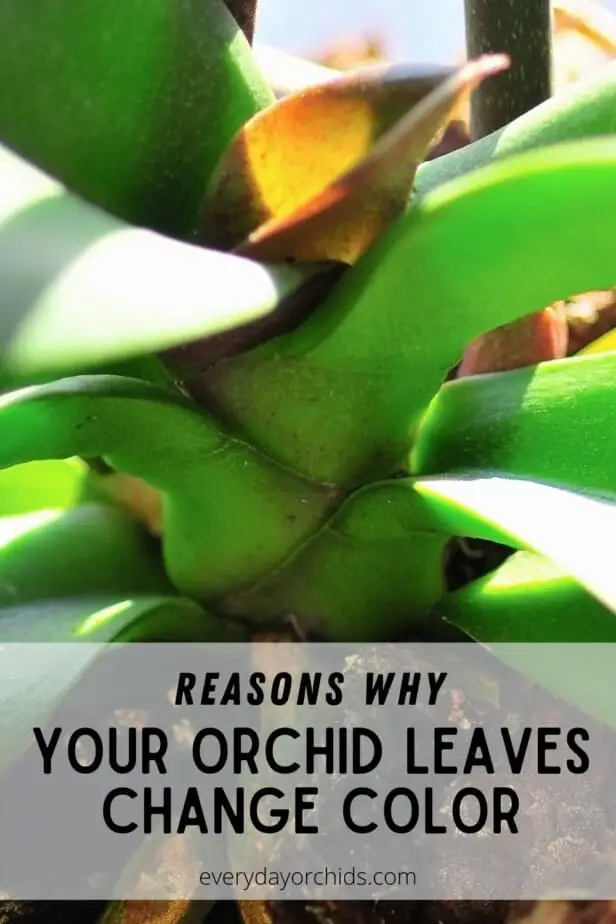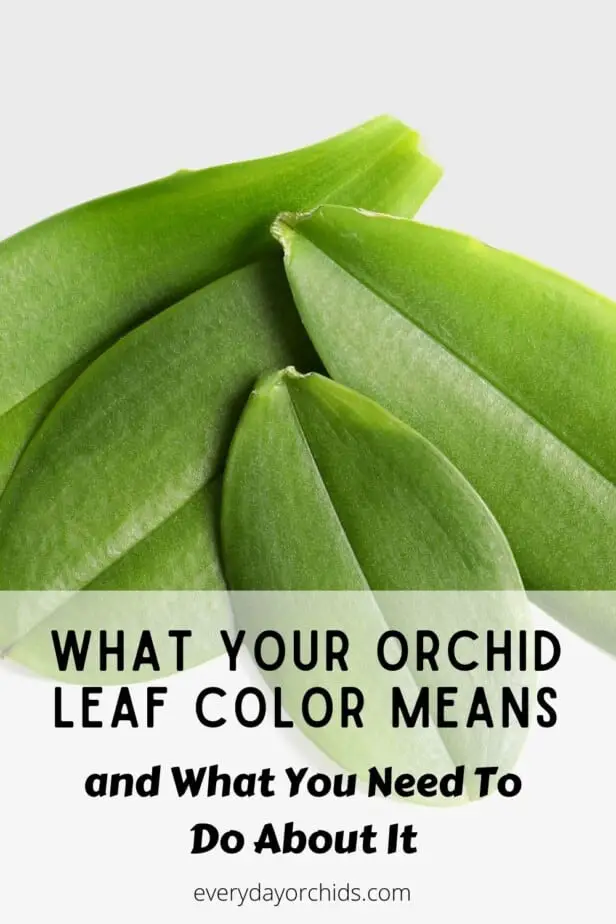Healthy orchid leaves usually have green or yellowish-green color. It is a sign that you are taking good care of them. However, there are times when your orchid leaves may change color and turn red, brown, white, or black. This can be alarming if you don’t know why this is happening.
What causes your orchid leaves to change color? More importantly, how can you get your orchid leaves back to their healthy-looking color?
Your orchid leaves can change color due to a variety of underlying issues. It is your orchid’s way of telling you that something is wrong. Red or purple leaves could mean that your orchid is getting too much light. Yellow or brown leaves could happen because of overwatering. White or black leaves could mean that the orchid is experiencing sunburn and requires immediate attention.
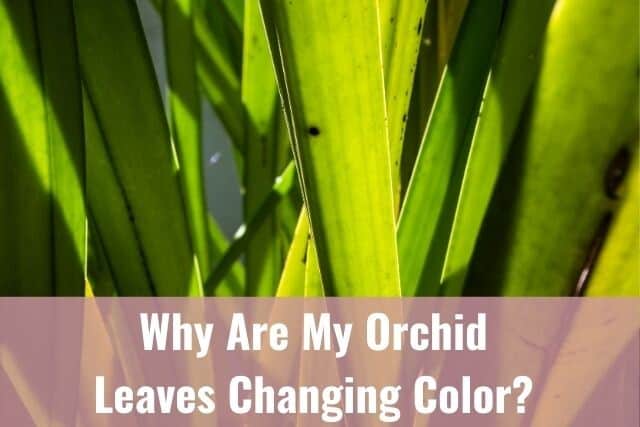
Aside from these reasons I mentioned above, there are many other reasons why orchid leaves change colors. I’ll go over how to interpret color changes in your orchid leaves. By the end of this article, you will have a better idea of why your orchid leaves change color. You will also know what to do about it. Keep reading to learn more.
Please note that these links are affiliate links and as an Amazon Associate, I earn from qualifying purchases. Purchases made through affiliate links in this post may generate commissions at no additional cost to you. Use this link for a discounted Amazon Prime trial. Thank you for your support!
Table of Contents
Why Are My Orchid Leaves Turning Red?
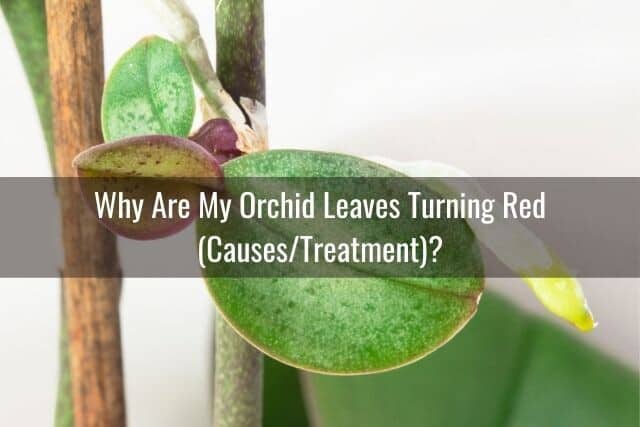
Orchids have various ways to tell you about their overall health and how they are doing in their environment. Sometimes, you can see gauge your orchid’s health by looking at its roots. Other times, you can look at the leaves and determine at a glance if your orchid is doing well or not.
If you notice that your orchid leaves are turning red, look to see where these reddish tones first started. Reddish tones on the underside of the leaf are normal and not a cause for concern.
The most common cause for the leaves to turn red or reddish is the genetics of the plant. Sometimes, one orchid will develop a reddish hint, while the other orchid growing next to it does not. Sometimes, the reddish color intensifies if the orchid gets more sunlight than what it is used to. This still does not mean something is wrong.
However, there are other causes for orchid leaves to turn red. These are the things that you should pay more attention to and I will go over these next. Not dealing with the following issues could cause permanent damage to your orchids.
Too Much Exposure to Sunlight or Heat
If the reddish hint that you see is on the leaf’s top surface, then you will need to investigate further. There are two reasons why this happens: too much sunlight or too much exposure to heat. Both may seem correlated, but the truth is that an orchid may get just the right amount of sunlight, but still become overheated.
The reddish hint on the surface of a leaf is sometimes caused by sunburn or a light response. You can move your orchid slightly away from the sunlight to reduce its exposure. You can also touch the leaf and feel if it is too hot. Too much heat can damage the leaf’s transport system, which causes the reddish hint on the surface.
You can reduce the amount of light if it seems like the orchid has been exposed to too much sunlight or heat. Simply move the orchid further away from the light or heat source. If the orchid is sitting near a window that gets a lot of afternoon sunlight, get a thin curtain. Use this to help block the intensity or reduce the amount of light that reaches the orchid.
Nutrient Deficiency
A lack of nutrients can also cause the orchid leaves to turn red. Even if your orchid is getting enough sunlight, air, and water, it may not be photosynthesizing properly. This will cause the orchid leaf to develop reddish spots. These reddish spots could mean that the orchid needs a bit more fertilizer.
You can address this by incorporating regular fertilization into your orchid care, if you are not already doing so. Be sure you use orchid-specific fertilizer. To learn more, check out this guide on how to fertilize an orchid.
If you are already fertilizing your orchids regularly, you may need to change or upgrade the fertilizer you are using. Alternatively, you may need to apply an additional, minimal amount of the fertilizer you are already using. You do not need to use a lot, especially if these are just reddish spots. A minimal increase should be enough to help your orchid with its photosynthesis. Try this for a few rounds of fertilization over a several week period. See if your orchid improves and the reddish spots go away.
Loss of Roots
Loss of roots are another reason why orchid leaves can develop a reddish tone. This can be challenging to identify because, sometimes, people confuse it with purplish hints.
When orchids lose roots, they develop reddish hints and shut down some of their production, including blooming. It also slows down the production of chlorophyll, causing the leaves to turn red.
The most common causes for root loss are poor air circulation, overwatering, and root rot. A less frequent cause of root loss is dehydration. Inspect the roots to see if there is visible damage, then cut off the dead roots and repot your orchid. You may also have to move the orchid to another location for better air circulation.
Insect and Fungus Infestation
If new foliage is forming a reddish hint on the leaves, this could be an SOS signal. Check the overall health of your orchid and see if it is suffering from an insect or fungus infestation. Although this might be a less likely scenario, you still need to check for insects or fungi. These can easily spread to and infect your other orchids.
First and foremost, if you do find an insect or fungal infection in your orchid plant, you will need to separate the affected orchid from the remainder of your plants. Do this to prevent the infection from spreading to your other orchids.
You will need to treat the orchid with the appropriate fungicide or remove the insects. It is also important to cut off the infected parts. Repot the orchid into a sterile pot with clean potting media.
You can read more about how to deal with a pest infestation on your orchids in another article. Also, check out my article on how to treat mold and fungal infections on your orchid plants. This way, you can figure out how to best deal with the infestation or infection before you start repotting.
Why Are My Orchid Leaves Turning Yellow?
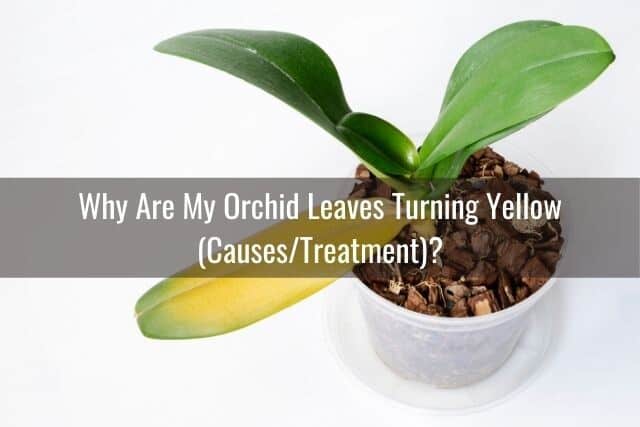
Of all the discolorations that your orchids may manifest, yellow leaves are the hardest to diagnose. This is because there are several reasons orchid leaves turn yellow. There are even some cases where a yellowish hint is a sign that the plant is healthy. However, if you start to notice your orchid leaf turning yellow, don’t just assume it is normal. There is a chance that your orchid has an underlying issue that needs to be treated.
When you notice your orchid leaves turn yellow, a good rule of thumb is to immediately assume the worst. Then as you investigate, you can tone the diagnosis down. If none of the above options seems to fit, then it is possible that the yellowing leaf color is due to the orchid’s genetics or old foliage.
Disease, Infestation, or Infection
Often, diseases caused by fungus, bacteria, or insects can cause the leaves to form yellowish hints on the underside of the leaf. If you notice this, you must treat the underlying condition right away. Leaving it untreated could worsen the discoloration. Eventually the leaves could turn black, both on the underside and surface of the leaves.
The first thing you need to do is to separate the orchid from the rest of your plants. This will prevent the disease from spreading. Keep monitoring the affected orchid for a few days and see if the yellow hints continue to spread.
If the yellow discoloration does continue to spread, use a sterile pair of gardening shears to cut off the infected part. Apply a powdered anti-fungal for orchids, such as ground cinnamon, to the cut end of the leaf. This will prevent further infection.
It would be best to repot the orchid in a sterile pot with new potting media such as this orchid mix. This will help ensure that the disease, infestation, or infection will not return.
Exposure to Chemicals
Different areas treat water differently, and some might use more chlorine than others. This chlorine in the water may be hard for orchids to process. The water you use for your orchids may also contain high magnesium and calcium levels. This can cause nutrient deficiency and eventually turn the leaves yellow.
Ideally, you call your local water company to ask for the recent tests they did with your tap water. Alternatively, you can buy a filtration system for your house and use filtered water for your orchids. However, before investing in a whole-house filtration system, try watering your orchid with store-bought filtered water first. See if that treats the discoloration.
Another alternative is to collect rainwater and use that to water your orchids instead of tap water. Normally, this would be at the top of my list because it is free and readily accessible. However, it is illegal in some states. Be sure to check the existing laws in your state before you start using collected rainwater for your orchids.
Nutrient Deficiency
There may be several reasons why your orchid may not get the nutrients that it needs to thrive. However, the end result will be the same. Your orchid will not produce enough chlorophyll, causing the leaves to turn yellow. The easiest way to treat this is to use a fertilizer. You may need to upgrade or change the orchid fertilizer you are using or use a little more.
Remember, even the slightest change in the nutrients that orchids absorb can cause discoloration. Although this discoloration is not as alarming as say, a pest infestation, it is still a sign that your orchid needs a bit more feeding.
Overwatering
Orchids need water, but too much of it can be detrimental. Overwatering prevents the plant from absorbing nutrients in the potting media and might even cause root rot. It is not something that you should feel bad about because many people accidentally over water their plants.
If you are worried that you may underwater them instead, don’t worry. Orchids tend to handle underwatering a lot better than overwatering. So, just water them once a week in warmer weather. Water once or twice a month in colder weather. This should get rid of the yellowish hints on the leaves.
You can learn more about how to water orchids here.
Why Are My Orchid Leaves Turning Brown?
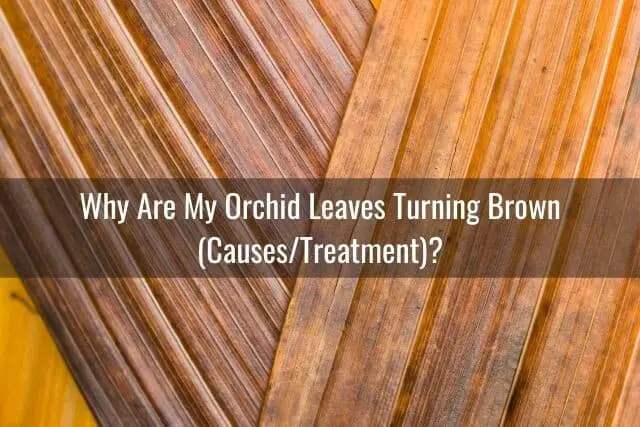
Healthy orchid leaves are green with hints of purple or yellow on the underside. If you notice that the leaves are turning brown, dry, and a bit brittle, your orchid is trying to tell you that something is wrong.
One common mistake that people make when they see their orchid’s leaves turning brown is that they treat the leaves. Doing so can temporarily fix the issue, but you need to fix the underlying problems. Otherwise, this could become a recurring issue for the plant.
Below are some of the common causes of why orchid leaves turn brown. None of them will require you to treat the leaves individually.
Dehydration
If the leaves start to turn brown and feel a bit dry and brittle, most likely, your orchid is dehydrated. There are two reasons why this happens. Either you are not watering your orchid regularly, or the roots are no longer absorbing water.
If the roots are no longer absorbing water, this can be due to rot. More likely, this is because the roots have shriveled up and died. Disease can also cause your orchid roots to no longer absorb water. In any case, if your orchid is not able to receive enough water, it will eventually die.
Lack of water is easy to fix. If the roots are still healthy and able to absorb water, you can increase the watering frequency. You can use the soaking method to water your plants or soak them in an Epsom salt solution. The leaves should be back to their healthy, green color in a few weeks.
However, if you are dealing with damaged or dead roots that can no longer absorb water, you will have to first remove them from the plant. Then, repot your orchid. Moving forward, start giving it a bit more water or just water regularly.
Fungal and Bacterial Infection
If you see brown spots on the leaves’ surface, it could also be because of a bacterial infection. If you see small, ringed brown spots on the leaves’ surface, your orchid likely has a fungal infection.
Overwatering and poor air circulation are the most common causes of these infections. Both conditions are not only bad for the infected orchid, but for other plants as well.
As soon as you notice these brown spots, separate the sick orchid from the rest of your plants. Next, remove the damaged root and infected parts of the plant. Bacterial and fungal infections spread fast. If the infection reaches the rhizome, the orchid will die out.
You also need to repot the orchid and apply a fungicide such as Physan20. Once you have dealt with the problem, try not to overwater the orchid in the future. Place it in a location with good air circulation.
Salt Damage Or Too Much Fertilizer
Fertilizer by itself will not cause the leaves to turn brown. Rather, it is the salt build-up that causes this damage. If the potting media contains too much salt, the leaves will slowly turn brown and eventually die out. It is rare for the potting materials to have too much salt. However, this can happen when a person uses too much fertilizer.
Fertilizers can leave traces of salt on the soil. Over time, the salt residue builds up, causing the discoloration on the leaf.
Fortunately, this is easy to fix. At least once a month, instead of fertilizing your orchids, just use plain water to water your orchids. This will help flush out any trace amounts of salt residue from the potting media.
When you do fertilize your orchids, just use small amounts of orchid-specific fertilizer once or twice a month. You will also need to dilute the fertilizer before using it to prevent this discoloration from happening again. Orchids prefer weak fertilizers.
Why Are My Orchid Leaves Turning Purple?
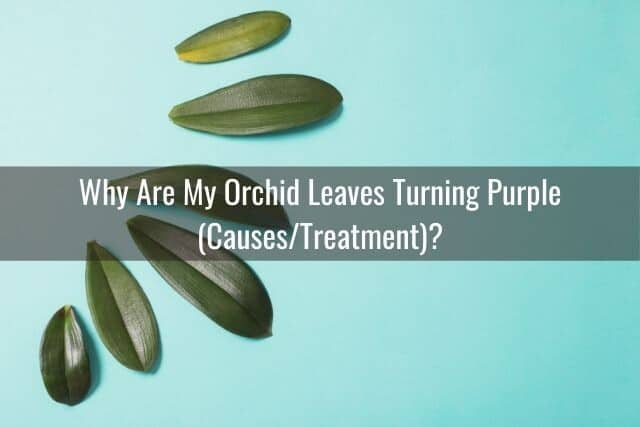
Orchid leaves that are turning purple color usually are not a cause for concern. In fact, many people consider purplish tones in their orchid leaves as a sign that the orchid is healthy.
Many orchids also have a natural purplish pigmentation. You might see a slight purple tinge forming on the underside of the leaf. This is perfectly normal.
However, there are other reasons why orchid leaves may develop purple tones. Some of these will require your immediate attention.
Too Much Exposure to Sunlight
If an orchid is exposed to too much sunlight, the plant will start to create a natural sunscreen. This is its way of trying to adapt to the environment. The leaves form anthocyanins to protect the orchid from harmful UV rays. It happens more often for low light orchids that get more sunlight than what they are used to.
This is easy to spot. If your orchid is getting too much sunlight, the leaves exposed to sunlight will develop a purplish color. Meanwhile, the shaded parts remain green.
This purplish undertone should not be a cause for concern. However, you still need to be careful. Prolonged exposure to too much sunlight may cause sunburn.
You will often get this purple discoloration if you mount your orchids on trees where one side gets too much sunlight and the other side does not. To fix this, you can try moving your orchid to a different location to reduce the amount of light it gets. The leaves will slowly return to a normal shade of green as it receives the correct amount of light.
Not Enough Exposure to Sunlight
Inadequate lighting is another reason why orchid leaves can develop a purple tone. Often, retailers do not put the species of the orchid on the pot—just the cultivator. That is why it can be tricky for some to identify their orchid species and know if the orchid is a bright light or low light grower.
If you are not familiar with your orchid or its particular lighting needs, you might accidentally end up with color changes in the leaves. You can learn more about how much light an orchid needs here. If your home doesn’t get much natural lighting, you may need to supplement with artificial lighting to meet your orchid’s needs.
For example, if you are caring for a bright light grower and not providing enough light, the leaves will darken and develop purple spots on the edges. This is not as alarming as it may seem because the orchid is only adapting to its environment.
However, if you notice that the purple spots are growing and starting to form large areas on the leaves, it is a sign that the orchid is struggling and needs more light.
If this happens, you can move your orchid to a brighter area. This way, it can receive a greater amount of light. Do not to place it under direct sunlight. You can use a sheer curtain to block any direct sunlight from hitting the plant.
In time, if the orchid is getting the right amount of light, then the orchid leaves will lose their purple tones and become green again.
Too Much Heat or Too Much Cold
Another reason why orchid leaves turn purple are temperature extremes. The orchid might be exposed to too much heat or too much cold. If your orchid is in a location with lots of sunlight, its leaves might turn purple due to heat exposure from the sunlight.
To determine if the area or lighting is too hot for the orchid, touch the leaf. If it feels warm, the sun might be “cooking” the leaf from the outside. This heat damage will prevent the plant tissue from transporting water throughout the orchid.
If this is the case, an easy and quick fix is to move the orchid away from the heat source. Make sure the new location will still allow the orchid to get enough sunlight. It is a fine balance between too much light, too little light and the ambient temperature. You can use a fan to help circulate cool air around the orchid to reduce risk for heat exposure.
Extreme cold is also not good for orchids. This is another reason why orchid leaves can develop purple tones.
If your area is expecting cold weather and a drop in temperatures, the safest thing to do for your orchids is move them indoors to protect them from the cold. If you keep your orchids outdoors in the summer, you may need to start transitioning them indoors during the fall. Prolonged exposure to low temperatures will cause the leaves to turn purple. Temperature extremes may even cause bud blast, cold damage, or frost damage.
Why Are My Orchid Leaves Turning White?
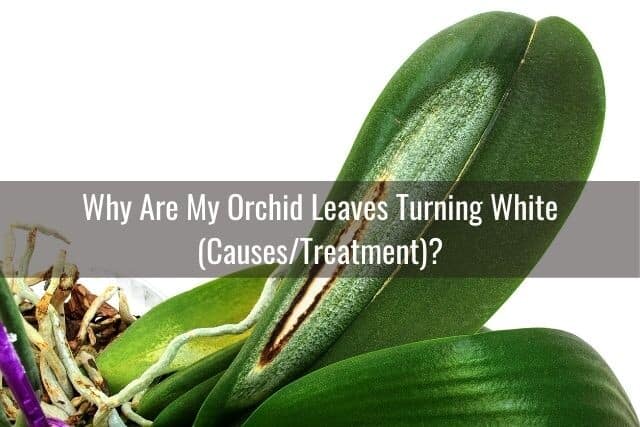
White orchid leaves are often an advanced stage of other discolorations I have discussed above.
If your orchid has received too much sunlight, the leaves will turn yellow, red or purple, and then, eventually, white. Although the white color indicates an advanced stage of a problem, it may still be reversible if you know what to do.
To effectively fix the problem and reverse the white discoloration on your orchid leaves, you need to understand what led up to the color change and fix the underlying issue. Remember, if you notice discoloration on orchid leaves, it is often due to an underlying problem.
Here are the most common causes why orchid leaves turn white:
Sunburn
Initially, you will notice that your orchid leaves develop purplish or reddish hints of color. This happens if the orchid is exposed to too much sunlight. However, there are extreme sunburn cases where excessive and prolonged sunlight exposure burns the leaves, causing them to turn white.
When you notice that your orchid leaves are losing their color, it is a sign that they are getting “cooked” from the outside.
As soon as you see this starting to happen, move your orchids. Move them out of direct sunlight. Place them in a different spot or further from the west-facing windows where the sunlight is most intense. The best place for your orchids is near a south or east-facing window. Here, they will not be exposed to the intense afternoon lighting coming from the west.
If you do not have this option, use sheer curtains to reduce the light intensity coming through the windows. You could also move your orchid further away from the window and towards the middle of the room.
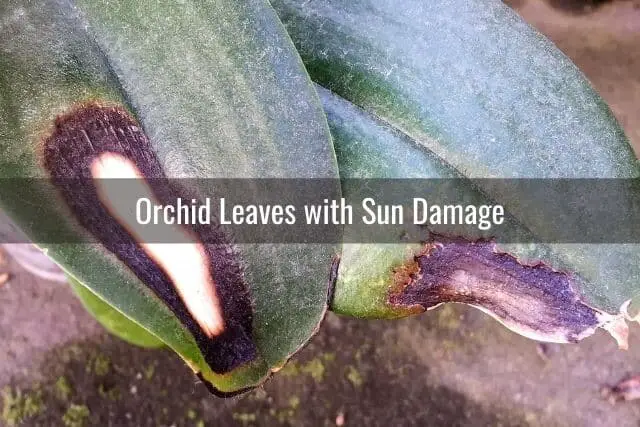
You have to make these changes as soon as you notice the white sunburned spots on the leaves. Left unattended, this area will continue to expand until the entire leaf eventually dies.
If the white discoloration is minor and has just only begun, it is possible for the plant to revert back to its natural green color. This process may take weeks to occur.
More often than not, however, the white discolored area on the leaf has died. You may see a black or brown ring around the white patch as in the picture above. These areas will be thin, brittle and dead.
If you have managed to move your orchid out of the direct light, the white area will be contained and no longer spread. The surrounding areas on the leaf that are still green will survive.
The picture above is the leaf of an orchid I have had for a long time. That sun damage occurred years ago. The orchid not only survived the sun damage, but has also continued to rebloom year after year and produce new leaves. So all is not lost!
Remember that although that sunburned section of the leaf has died, the rest of the leaf is still viable. There is no need to remove it from the rest of the orchid. At this point, it is more of a cosmetic blemish on your orchid. It is also a reminder (for me at least) to make sure the orchid is not left outside, exposed to too much sunlight.
Nutrient Deficiency
If the orchid is not able get enough nutrients from the soil, you might start to notice yellowish or reddish hints on the leaves.
If left unchecked, an extended lack of nutrients can cause the edges of the leaves to turn white. This may continue to spread if nothing is done to feed the plant.
Several issues may arise from the lack of nutrients and may even cause the roots to stop absorbing water.
If you notice even the slightest yellowish or reddish hints on your orchid leaves, start using an orchid fertilizer. Do this before it gets to the white discoloration stage. Follow the package instructions and dilute it appropriately. If you already are feeding your plants regularly with fertilizer, consider upgrading your fertilizer or using a little more.
Just be mindful that when adding fertilizer, too much of it can also be detrimental to an orchid’s health. If you are going to increase the amount of fertilizer used, do so incrementally. Assess your orchid’s response before adding more.
Light Response
Another reason why orchid leaves turn white, especially around the edges, is due to how much light they receive. Too much light for orchids that are low light growers or not enough light for bright light growers can cause this discoloration. This is why it is so important to know what kind of orchid you have and its specific lighting needs.
This type of white discoloration on the edges of the leaves is different from sunburn and sun damage. Often, this discoloration due to the light response is not as alarming as sunburn. However, you will still need to address it. It could mean that your orchid’s ability function properly and produce chlorophyll could be compromised.
For orchids that are low light growers, such as Phalaenopsis and Paphiopedilum orchids, make sure that the orchid is away from direct sunlight and has adequate indirect bright lighting. Bright light growers, such as Dendrobiums, need a location with high levels of bright light. Avoid putting them under direct sunlight to prevent sunburn.
Why Are My Orchid Leaves Turning Black?
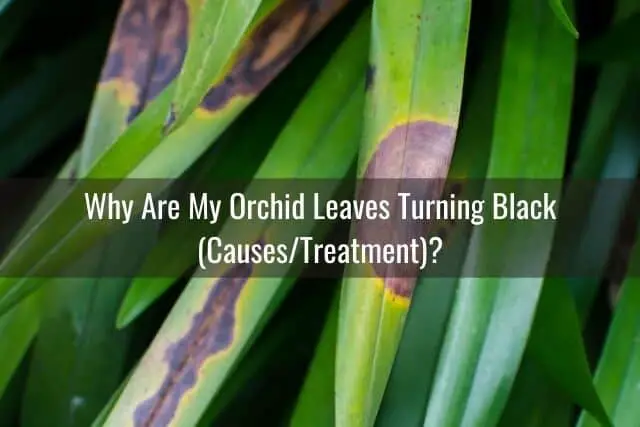
In terms of aesthetics or health, black is never a good sign for orchid leaves. When you see your orchid leaves change color to black, it is usually a sign of a bigger problem. However, there are still a few things that you can do to fix the root cause.
Here are some of the reasons why orchid leaves turn black:
Irreversible Sunburn
Sunburn is a common reason why orchid leaves turn black. This is a gradual process, and you will first notice red or purple discolorations on your orchid leaf, followed by white discolorations. The orchid leaf will also feel hot to the touch. There might be other signs that your orchid is getting too much intense lighting.
If you are able to move your orchid before the whole plant dies, you have a chance to save your orchid. That white sunburned area on your orchid leaf may become surrounded by a black or brown ring of dead tissue. Unfortunately, this damage is irreversible. That portion of the leaf will die off. If it is a small section, the rest of the leaf will remain attached to the orchid and continue to live, but otherwise, the entire leaf will eventually die off.
You can avoid this from happening by checking on your orchids regularly. Inspect the leaves for any color changes. Make sure your orchids are not exposed to direct sunlight for prolonged periods of time.
Avoid placing your orchids near west-facing windows, which typically receive the most intense sunlight of the day. Instead, place your orchids near south or east-facing windows if possible. Alternatively, you can purchase a sheer, gauzy or thin curtain to cover your window. This will help block some of the more intense rays from the sun, while still allowing your orchid to receive bright, indirect light.
Bacterial or Fungal Infection
Bacterial or fungal infections may start as small, dark brown spots. Over time, the leaves will turn black as the infection spreads and worsens.
These infections can also spread from one orchid to another. You have to be proactive about isolating your sick orchid from the rest of your plants immediately. Do this as soon as you notice the dark spots on the leaves. Do this even before you diagnose whether it is a bacterial or fungal infection or pest infestation. You can always figure out what to do later. One of the most important things you can do is to keep your healthy plants away from the ill orchid.
The fungi Pythium ultimum and Phytophthora cactorum are common causes for these dark brown spots on the leaves. They can affect a wide variety of orchids. This fungal infection can spread quickly, turning the leaves black as the infection spreads. It may even destroy the whole plant if left untreated.
The best way to deal with this is to cut off the infected parts using a sterile knife. You will also need to repot the orchid, using a sterilized pot. Use new, clean potting media to stop the spread of infection.
To be sure that it will not recur, you should also apply a fungicide on the infected part. Some people even spray fungicide on the rest of the orchid in order to kill off any lingering bacteria or fungi.
After doing all this, you will still want to keep your orchid away from your other plants for another week or two. Continue to inspect it regularly. Put your orchid back with your other plants only when you are certain the fungal or bacterial infection has been eradicated.
Hard Water and Fertilizer
Excessive amounts of mineral deposit and fertilizer built up in the potting media can also cause the orchid leaves to turn black over time. In some areas, the tap water may contain mineral deposits. The root absorbs and transports these minerals through the leaves, causing it to turn black.
To address this, you may want to consider using filtered water to water your orchids. If you do this, observe to see if the condition improves in a few weeks.
Using too much fertilizer on your plants can also cause the leaves to turn black. Remember, you always have to find a balance when using fertilizer. Too much or too little can cause discoloration on the leaves. Although important, fertilizers may also be detrimental to an orchid’s health, and the results may, sometimes, be irreversible.
Final Thoughts
Plants have various ways to communicate with us. Orchids are even more fascinating because the orchid leaves change color, making it possible for us to figure out what is going on. Some of the discolorations that you will notice are through genetics and usually are not a cause for concern.
However, there are also some discolorations that you have to pay more attention to because they can worsen over time. Some changes in the color of your orchid’s leaves may even require you to act with urgency because of how quickly the problem could spread. Fortunately, these discolorations are rarely irreversible. You can do many things to address them and improve the health of your orchid.
If you enjoyed this article, please pin it and share!
